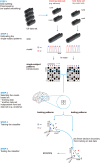Revealing representational content with pattern-information fMRI--an introductory guide
- PMID: 19151374
- PMCID: PMC2656880
- DOI: 10.1093/scan/nsn044
Revealing representational content with pattern-information fMRI--an introductory guide
Abstract
Conventional statistical analysis methods for functional magnetic resonance imaging (fMRI) data are very successful at detecting brain regions that are activated as a whole during specific mental activities. The overall activation of a region is usually taken to indicate involvement of the region in the task. However, such activation analysis does not consider the multivoxel patterns of activity within a brain region. These patterns of activity, which are thought to reflect neuronal population codes, can be investigated by pattern-information analysis. In this framework, a region's multivariate pattern information is taken to indicate representational content. This tutorial introduction motivates pattern-information analysis, explains its underlying assumptions, introduces the most widespread methods in an intuitive way, and outlines the basic sequence of analysis steps.
Figures



References
-
- Bandettini PA, Cox RW. Event-related fMRI contrast when using constant interstimulus interval: Theory and experiment. Magnetic Resonance in Medicine. 2000;43:540–8. - PubMed
-
- Birn RM, Cox RW, Bandettini PA. Detection versus estimation in event-related fMRI: Choosing the optimal stimulus timing. Neuroimage. 2002;15:252–64. - PubMed
-
- Carlson TA, Schrater P, He S. Patterns of activity in the categorical representations of objects. Journal of Cognitive Neuroscience. 2003;15:704–17. - PubMed
Publication types
MeSH terms
Grants and funding
LinkOut - more resources
Full Text Sources
Medical

